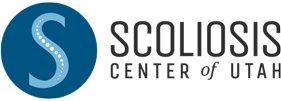Blogs
Which Side Is Weaker with Scoliosis? Expert Answers
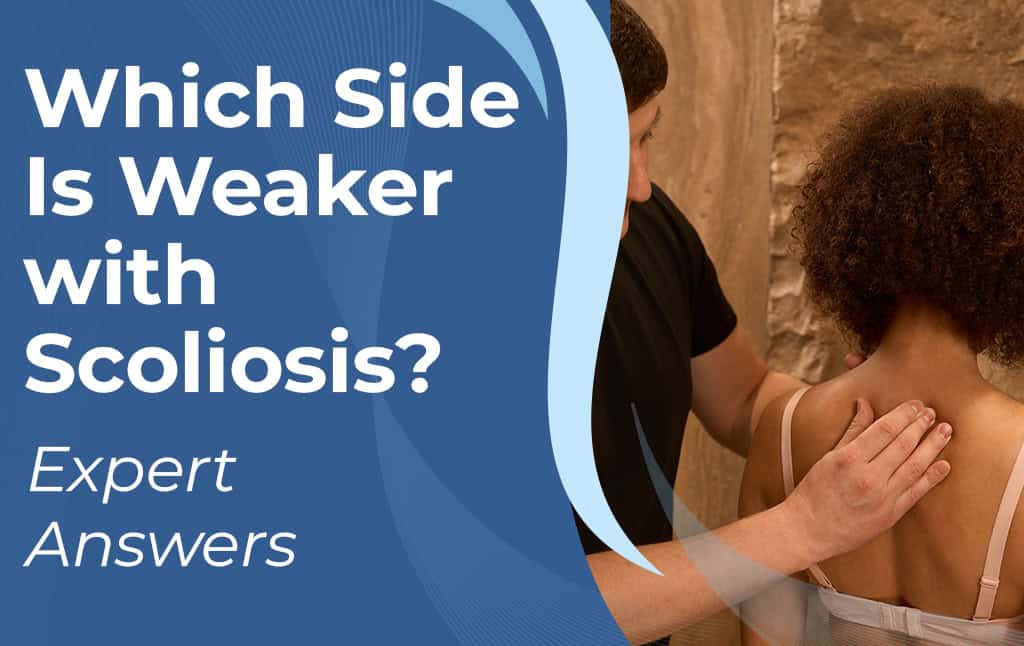
Scoliosis is an asymmetrical condition that causes the development of an unnatural sideways-bending and rotating spinal curve; one of its main effects is disrupting the body’s symmetry through postural deviation. A potential effect of scoliosis is a muscular imbalance as the muscles on one side of the spine are overused, while muscles on the other side can become weak from lack of use.
Scoliosis disrupts the balance and stability of the spine by causing a loss of its healthy curves. With typical scoliosis curves that bend to the right, the left side is weaker because the muscles on the right side of the spine attempt to counteract the condition’s uneven forces.
A muscular imbalance is a common effect of scoliosis and can cause sore and strained muscles.
Scoliosis Muscular Imbalance
Scoliosis affects all ages, has multiple condition types, and ranges in severity from mild scoliosis to moderate and severe scoliosis.
Although scoliosis causes the spine to bend and twist unnaturally, its effects aren’t limited to the spine; changes to the spine’s structure, flexibility, strength, and/or balance can affect the body in a number of ways.
Scoliosis causes the spine to become misaligned, which can extend to the entire body from the head to the feet; a body that’s asymmetrical is dealing with uneven forces.
The condition’s main effects, particularly in children, are postural changes such as the development of uneven shoulders, shoulder blades, uneven hips, and a rib cage arch, and these types of changes also disrupt balance, coordination, and gait; an additional condition effect is muscular imbalance.
In adults, the main symptom of scoliosis is pain caused by compression; uneven pressure comes into effect when growth has stopped, and scoliosis pain can involve the back, radiating nerve pain, and/or muscle pain.
It’s not just the spine that maintains its healthy curves and the alignment of its vertebrae; the spine’s surrounding muscles provide crucial support and stability for the spine.
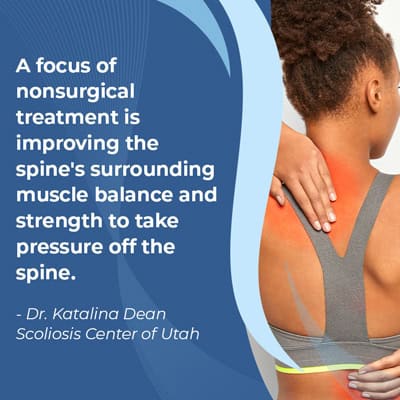 A focus of nonsurgical treatment is improving the spine’s surrounding muscle balance and strength to take pressure off the spine.
A focus of nonsurgical treatment is improving the spine’s surrounding muscle balance and strength to take pressure off the spine.
The Left Side is Weaker
In most cases of typical idiopathic scoliosis, curves bend away from the heart, to the right, known as dextroscoliosis, and the muscles on the right side of the spine will be stronger, but tighter, because they are working harder to counteract the unnatural spinal curve.
The muscles on the left side of the spine will be weaker, and stretched, because they are underused. The body tries to compensate for uneven forces, and a muscular imbalance can develop as the spine’s surrounding muscles attempt to counteract those uneven forces to re-balance the spine.
In atypical cases of scoliosis with curves that bend to the left side, known as levoscoliosis, the right side will be weaker.
Scoliosis Progression
As a progressive condition, the nature of scoliosis is to become more severe over time, and while we don’t fully understand what causes most cases of scoliosis to develop, we know it’s growth that makes them progress.
So patients who have not yet reached skeletal maturity have more potential progression to face, and the more a condition progresses, the stronger its uneven forces are, the more noticeably they are going to affect the body, and the more unbalanced the spine and its surroundings muscles can become.
A scoliosis diagnosis of mild scoliosis, for example, doesn’t mean that’s where the condition will stay, not without active treatment working to counteract the condition’s progressive nature.
As progression causes increasing condition severity and related symptoms, a muscular imbalance can become worse over time, and as this happens, it becomes harder to reverse.
The best way to treat scoliosis is proactively so progression can be prevented, along with increasing symptom severity and the need for invasive future surgical intervention.
As mentioned, scoliosis affects all ages, but the most common type is adolescent scoliosis, most often diagnosed in females between the ages of 11 and 15.
Adolescents are also the most at risk for fast progression because of the intense growth spurts of puberty: highlighting, again, the importance of proactive treatment that prioritizes preventing progression.
Proactive Conservative Scoliosis Treatment
Here at the Scoliosis Center of Utah, patients experience an innovative individualized approach that combines multiple treatment disciplines to correct scoliosis on every level.
When it comes to the condition’s underlying structural nature, condition-specific chiropractic care can work towards manually adjusting the vertebrae at the curve’s apex, but structural changes have to be supported: where the spine’s surrounding muscles come in.
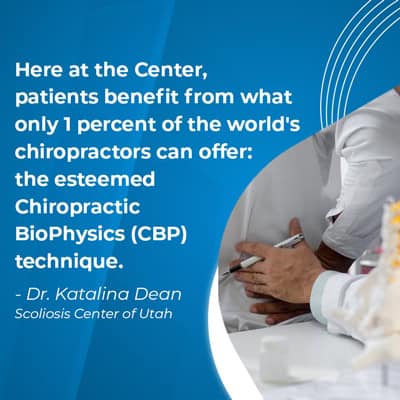 Here at the Center, patients benefit from what only 1 percent of the world’s chiropractors can offer: the esteemed Chiropractic BioPhysics (CBP) technique.
Here at the Center, patients benefit from what only 1 percent of the world’s chiropractors can offer: the esteemed Chiropractic BioPhysics (CBP) technique.
Chiropractic BioPhysics is a combined approach to identifying and addressing symptoms caused by vertebral subluxations (misaligned spine); it takes the best of what the studies of biology, physiology, physics, geometry, and anatomy have to offer and integrates them into chiropractic care.
A spine that doesn’t have its vertebrae stacked on top of one another in a straight, neutral, and healthy alignment can cause poor posture, pain, a loss of healthy spinal curves (scoliosis), spinal degeneration, disc issues including herniation, back pain, neck pain, movement changes, headaches and migraines.
So as you can see, an unhealthy and/or unbalanced spine can disrupt overall health and quality of life in a number of ways.
ScoliBalance®
Through a comprehensive scoliosis-specific exercise program, ScoliBalance®, the potential of chiropractic and physical therapy are combined to customize exercise programs specific to each individual patient and their condition.
Through the use of customized mirror image exercises, patients are taught postural awareness: to always be mindful of how body positioning can affect the spine’s alignment and healthy curves.
These exercises can easily be performed at home so patients can continue to rehabilitate and sustain treatment results.
ScoliBalance® therapy is a complete approach to customized scoliosis care that can slow/stop progression, help reduce curve size, increase spinal flexibility, improve the spine’s balance and alignment, and it can also improve the spine’s surrounding muscle balance and strength.
Increasing core strength means a spine that’s better supported and doesn’t have to work as hard to maintain its natural curves and alignment.
Weaker muscles surrounding the spine means a spine that can experience more movement, and while we want spines to be flexible, we don’t want too much movement within the spine; this makes it unstable and vulnerable to injury.
ScoliBalance® can restore balance to the spine, its surrounding muscles, and the entire body because the underlying cause of scoliosis symptoms is the spine’s misalignment.
Another key facet of nonsurgical scoliosis treatment is corrective bracing.
ScoliBrace®
The concept of wearing a tight-fitting orthotic device around the torso to alter the spine’s position is not a new one, but scoliosis bracing has evolved over the years, offering powerful corrective results, particularly when combined with ScoliBalance® therapy.
The ScoliBrace® addresses scoliosis in all three dimensions because the spine’s rotational component makes the condition 3-dimensional; traditional scoliosis bracing is limited in its potential efficacy because it addresses scoliosis as 2-dimensional, ignoring the rotational component.
The ScoliBrace® uses advanced scanning software to ensure that each brace is uniquely shaped to suit an individual’s body and condition type, and this helps address the main challenge of scoliosis bracing: compliance.
As a child’s spine is still growing, it’s more responsive to bracing, and as growth is what triggers progression, the focus of childhood scoliosis treatment is on achieving a curvature reduction that can be sustained during periods of growth.
When the corrective ScoliBrace® supports the changes worked towards through chiropractic care and scoliosis-specific exercise programs like ScoliBalance®, nonsurgical treatment can offer some impressive potential results, without the potential risks associated with surgical treatment.
But the sooner treatment is started, the better, so don’t hesitate to reach out for assessment.
Conclusion
Every case of scoliosis is unique, but most cases involve a typical idiopathic scoliotic curve that bends to the right, and in these cases, this means the left side will we weaker as the right side is working harder to try and counteract the spine’s unnatural bend and twist.
If an atypical curve bends to the left towards the heart, the right side will have weaker muscles because the left side will be working harder to counteract the spine’s unnatural pull.
When the uneven forces of scoliosis pull the spine’s surrounding muscles in opposite directions, a muscular imbalance can develop, and this can lead to sore, stiff, and strained muscles, as well as painful muscle spasms.
A muscle imbalance needs to be taken seriously, particularly when they’re caused by progressive conditions that can get worse over time.
The most important thing to understand about scoliosis is that its effects can be minimized through proactive treatment that addresses the underlying cause of its symptoms: the spine’s misalignment.
Without treatment, it’s likely conditions will continue progressing, and untreated scoliosis that becomes severe can develop a number of complications, not to mention the potential necessity for invasive surgical treatment.
There are never treatment guarantees, but particularly with early detection and intervention, scoliosis can be highly responsive to conservative treatment options.
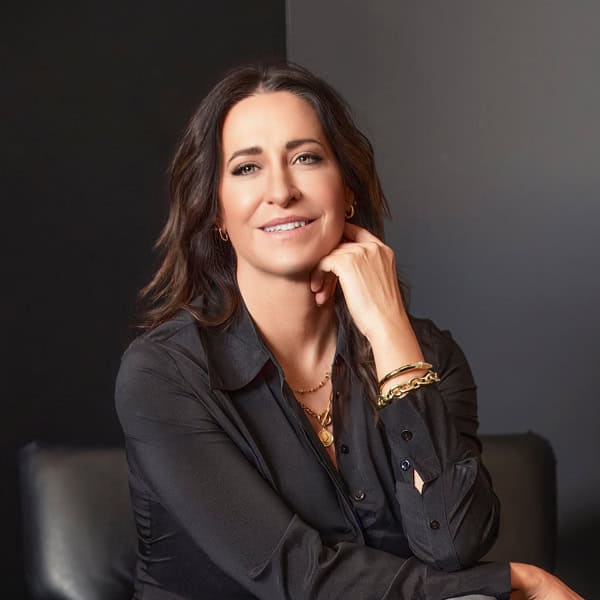
Dr. Katalina Dean
Dr. Katalina Dean is the founder and clinical director of Scoliosis Center of Utah, in Midvale, UT. Her team specializes in posture correction, spinal rehabilitation, and non-invasive scoliosis care and bracing.
Call Today
Do You Qualify for Care?
Schedule an Appointment Below
